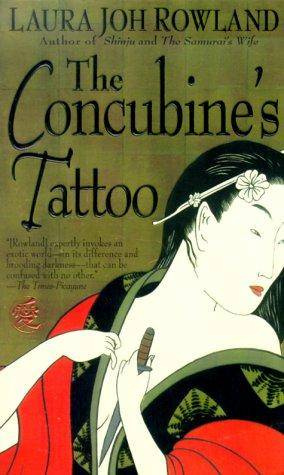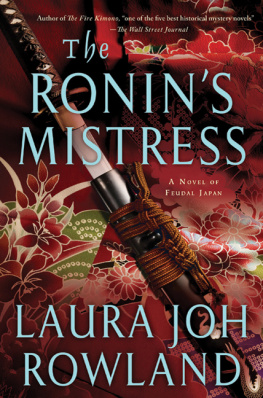
Laura Joh Rowland
The Concubines Tattoo
The fourth book in the Sano Ichiro series, 1998
To Pamela Gray Ahearn, With appreciation
EDO
Genroku Period, Year 3, Month 9
(Tokyo, October 1690)

*
It is my privilege to open this ceremony in which Ssakan Sano Ichir and Lady Ueda Reiko shall be united in marriage before the gods. Pudgy, nearsighted Noguchi Motoori-Sanos former superior and the go-between who had arranged the match-solemnly addressed the assembly gathered in Edo Castles private reception hall.
On this warm autumn morning, sliding doors stood open to a garden resplendent with scarlet maple leaves and brilliant blue sky. Two priests, clad in white robes and tall black caps, knelt at the front of the hall before the alcove, in which hung a scroll bearing the names of the kami-Shinto deities. Below this, a dais held the traditional offerings of round rice cakes and a ceramic jar of consecrated sake. Two maidens, wearing the hooded cloaks of Shinto shrine attendants, stood near the priests. On the tatami to the left of the alcove knelt the brides father and closest associates: stout, dignified Magistrate Ueda and a few relatives and friends. To the right, the grooms party consisted of Shogun Tokugawa Tsunayoshi, Japan s supreme military dictator, dressed in brocade robes and the cylindrical black cap of his rank, attended by several high officials; Sanos frail, elderly mother; and Hirata, Sanos chief retainer. All eyes turned to the center of the hall, the focus of the ceremony.
Sano and Reiko knelt side by side before two small tables-he in black ceremonial robes stamped with his familys gold flying-crane crest, his two swords at his waist; she in a white silk kimono and a long, white silk drape that completely covered her face and hair. They faced a flat porcelain dish containing a miniature pine and plum tree, a bamboo grove, the statues of a hare and a crane: symbols of longevity, pliancy, and fidelity. Behind them, Noguchi and his wife knelt at a table reserved for the go-between. As the priests stood and bowed to the altar, Sanos heart pounded. His stoic dignity hid a turmoil of emotion.
The last two years had brought him continuous upheaval: the death of his beloved father; the move from his modest family home in the Nihonbashi merchant district to Edo Castle, Japan s seat of power; a dizzyingly rapid rise in status and all the associated challenges. At times he feared his mind and body couldnt withstand the relentless onslaught of change. Now he was marrying a twenty-year-old girl hed met exactly once before, more than a year ago, at the formal meeting between their two families. Her lineage was impeccable, her father one of the wealthiest and most powerful men in Edo. But theyd never spoken; he knew nothing of her character. He barely remembered what she looked like, and wouldnt see her face again until the end of the ceremony. To Sano, the tradition of arranged marriage now seemed like sheer madness-a potentially disastrous pairing of strangers. What perilous turn had his fate taken? Was it too late to escape?
From her tiny bedchamber in the Edo Castle womens quarters, the shoguns newest concubine heard hurrying footsteps, slamming doors, and shrill feminine voices. The dressing rooms would be littered with opulent silk kimonos and spilt face powder, the servants rushing to finish dressing the two hundred concubines and their attendants for the ssakan-samas wedding feast. But Harume, weary of the suffocating presence of so many other women after only eight months at the castle, had decided to skip the celebration. Privacy was almost nonexistent in the crowded womens quarters, but now her chambermates were gone, the palace officials busy. The shoguns mother, whom Harume attended, hadnt required her services today. No one would miss her, she hoped- because Harume meant to take full advantage of her rare solitude.
She latched the door, then closed the shutters. On a low table she lit oil lamps and incense burners. The flickering flames cast her shadow against the mullioned paper walls; the incense smoked, sweetly pungent. A hushed, secretive atmosphere permeated the room. Harumes pulse quickened with a dark excitement. She set a rectangular black lacquer box, its lid inlaid with gold irises, and a porcelain sake decanter and two cups on the table. Her movements were slow and graceful, befitting a sacred ritual. Then she tiptoed to the door and listened.
The noise had diminished; the other women must have finished dressing and started toward the banquet hall. Harume returned to the altar shed created. With eagerness rising in her breast, she pushed back her glossy, waist-length black hair. She loosened her sash and parted the skirts of her red silk dressing gown. She knelt, naked from the waist down.
She contemplated herself with pride. At age eighteen, she was as ripe of flesh as a mature woman, yet with youths fresh radiance. Flawless ivory skin covered her firm thighs, her rounded hips and stomach. With her fingertips Harume, stroked the silky triangle of pubic hair. She smiled, remembering his hand there, his mouth against her throat, their shared rapture. She reveled in her eternal love for him, which she would now prove beyond any possible doubt.
One of the priests swished a long wand tasseled with white paper strips, crying, Evil out, fortune in! Whoosh! Whoosh! to purify the room. Then he chanted an invocation to the Shinto gods Izanagi and Izanami, revered procreators of the universe.
Hearing the familiar words, Sano relaxed. The timeless ceremony lifted him above doubt and fear; anticipation soared in him. No matter the risks, he wanted this marriage. At the advanced age of thirty-one, he was at last ready to make the decisive step into official adulthood, to take his place in society as the head of his own family. And he was ready for a change in his life.
His twenty months as the shoguns ssakan-sama-most honorable investigator of events, situations, and people-had been a nonstop cycle of criminal cases, treasure hunts, and spying assignments, culminating in a near-catastrophic trip to Nagasaki. There he had investigated the murder of a Dutch trader-and been shot, almost burned to death, charged with treason, and nearly executed before clearing himself. Hed returned to Edo seven days ago, and while he hadnt lost his desire to pursue truth and deliver criminals to justice, he was tired. Tired of violence, death, and corruption. The aftermath of a tragic love affair the previous year had left him lonely and emotionally drained.
Now, however, Sano looked forward to a respite from the rigors of his work. The shogun had granted him a months holiday. After a yearlong betrothal, Sano welcomed the prospect of a private life with a sweet, compliant wife who would provide a haven from the outside world. He yearned for children, especially a son who would carry on his name and inherit his position. This ceremony was not just a social rite of passage, but a gateway to everything Sano wanted.
The second priest played a series of high-pitched, wailing notes on a flute, while the first beat a sonorous accompaniment on a wooden drum. Now came the most solemn, sacred part of the wedding ritual. The music ceased. One attendant poured the consecrated sake into a long-handled brass ewer and brought it to Sano and Reiko. The other attendant set before them a tray containing three flat wooden cups, graduated in size, nested together. From the ewer, the attendants filled the first, smallest cup, bowed, and handed it to the bride. The assembly waited in hushed expectation.
Harume opened the lacquer box and took out a long, straight razor with a gleaming steel blade, a pearl-handled knife, and a small, square black lacquer jar with her name painted in gold on the stopper. As she arranged these objects before her, a tremor of fear fluttered in Harumes throat. She dreaded pain, hated blood. Would someone interrupt this ceremony-or worse, discover her secret, forbidden liaison? Dangerous intrigues shadowed her life, and there were people who might wish to see her disgraced and banished from the castle. But love demanded sacrifice and necessitated risk. With unsteady hands she poured sake into the two cups: one for herself; a ritual one for her absent lover. She lifted her cup and swallowed the drink. Her eyes watered; her throat burned. But the potent liquor enflamed her courage and determination. She picked up the razor.
Next page







